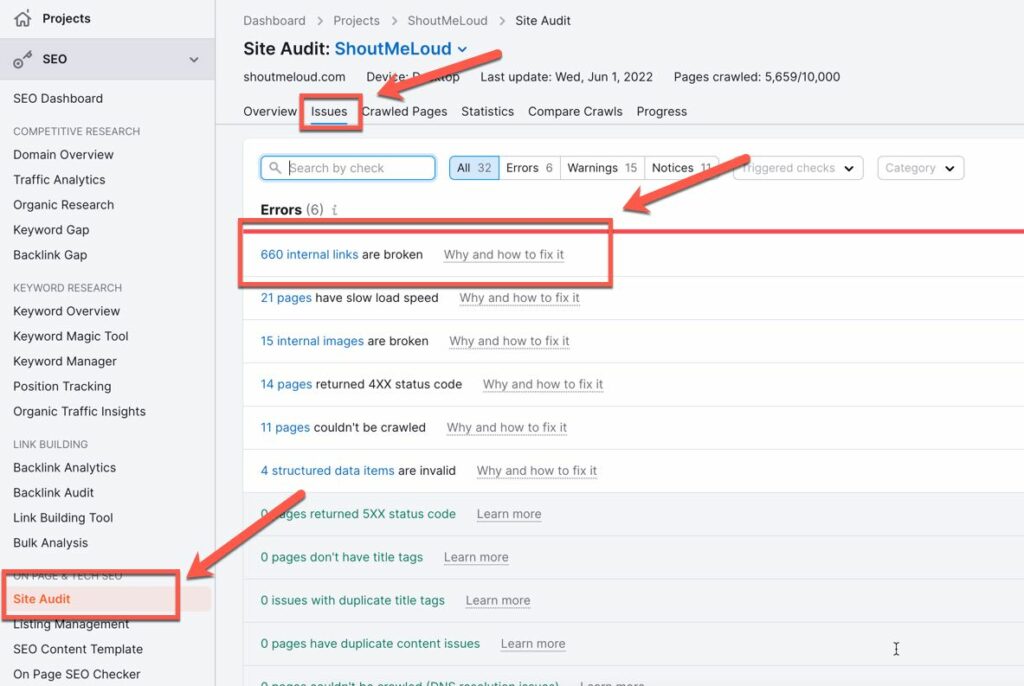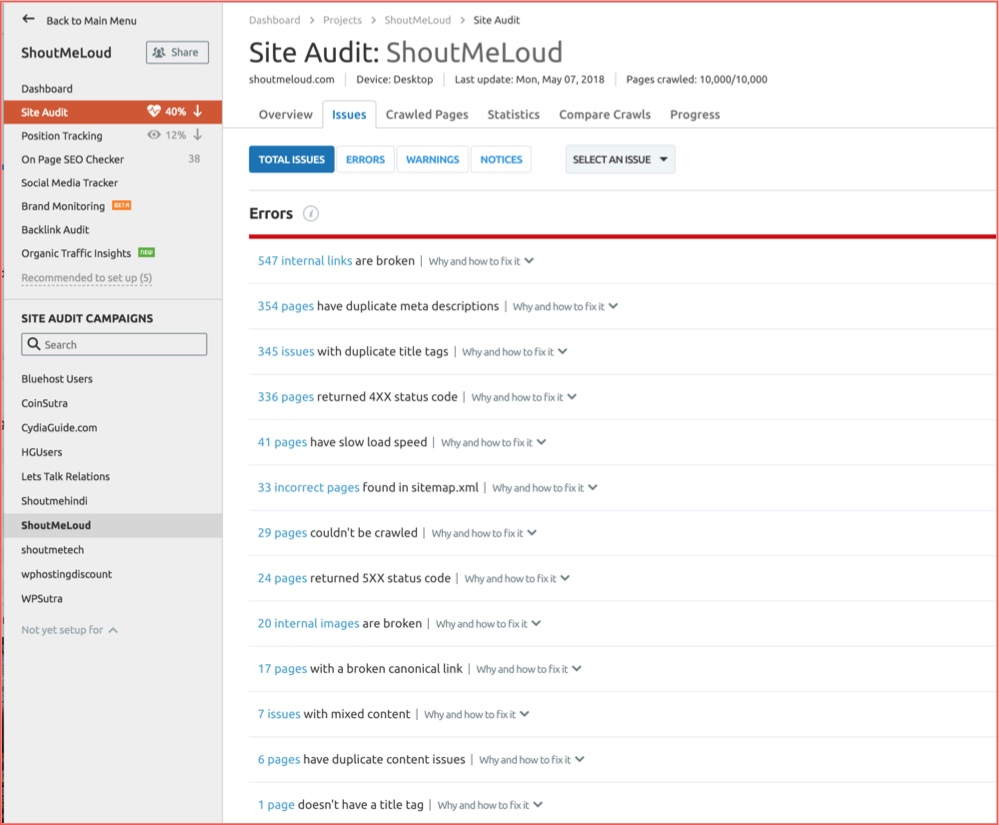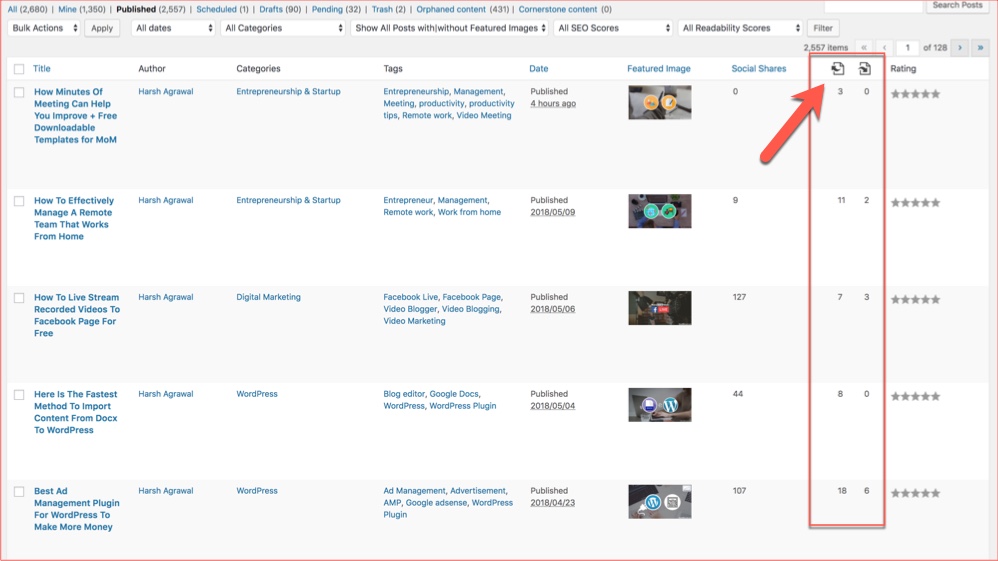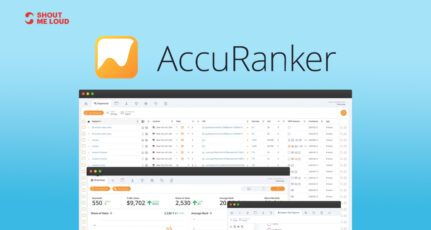
Struggling with low traffic on your blog?
Well, the first thing you could do to improve your organic traffic is to work on your On-Page SEO and On-site SEO.
ShoutMeLoud gets more than 1.5 million page views a month, and 80% of our traffic is organic. It would not have been possible without high-quality content and technically sound SEO. Today, you will learn about one important SEO factor that will help you improve your overall SEO score and thus organic ranking.
Internal linking is one of the most overlooked factors by webmasters and those who hire writers for the content.
Link Whisper is the best internal link building WordPress plugin. It offers featuers that will help you improve your internal links within hours, if not days.
What is internal linking in SEO?
Internal links are links from one blog post or a page to another within the same domain. Internal links help search engines crawl the pages effectively. More than that, it helps to pass the link juice from one page to another.
Let’s understand with an example:
Let’s say you have a webpage that has received about ten high-quality backlinks from other domains. Now that page is already ranking higher in the SERP and what you can do here is you can link to other pages of your websites from that high-ranking page and thus pass on the link juice to other pages which are not yet strong in terms of backlinks.
To build an authoritative website, you need to ensure all pages of your blogs are interlinked, and this is where the internal linking technique comes into the picture.
A good example of a solid internal linking structure is Wikipedia, and we all know how well Wikipedia ranks in search engines.
Now that you understand what internal linking is, it’s time to learn some advanced tips and tricks for getting this technique right.
How to start internal linking in WordPress
The thumb rule of internal linking is that pages should be contextually relevant.
Take advantage of anchor text internal links.
- Related posts after posts, and
- Popular posts in the sidebar…
…are some of the easiest ways to add internal links to a webpage. In the WordPress ecosystem, you can use Internal linking WordPress plugins for quick internal linking.
You should look up to Wikipedia and add 7-10 internal links in an article of 1200 words. There is no limit for internal links as long as they are contextually relevant and helpful for users.
I usually add internal links while writing a piece of content or when proofreading it. If you have an editor in your organization, you should train him for adding internal links while editing content.
Recently, I switched to the Linkwhisper plugin, and it has a really pleasant feature that recommends the relevant article that one could use to add within the article.
If you plan to add the internal links to a blog with over 200+ blog posts, this plugin will save a lot of time
But how about old posts?
How do you find pages that have low incoming links or pages where you haven’t added enough internal links? In this next section, you will learn how to identify such pages. Once you do that, you can start editing them.
Finding pages with low incoming or outgoing internal links
Low incoming links
The best way to improve your internal link is by identifying pages with the least internal links. Every page should have 1-2 internal links (referenced from other pages).
Update: If you are using WordPress, You can use the Linkwhisper plugin to find pages with low incoming internal links.
Or we can use Semrush tool site audit feature. I have talked about Semrush a couple of times in my earlier articles, and this is the SEO suite I’m using for the past couple of years.
If you are using Semrush, then use its inbuilt feature to find pages with low incoming links. If you are not using the Semrush, and using the Yoast SEO plugin, read the next section where I have shared how you can do the same using the Yoast SEO WordPress plugin.
You can get Semrush completely free for 14 days from here (valued at $300).
- Add your site to the site audit feature of Semrush Dashboard
- Run a complete site audit (the trial version also lets you do that)

Click on issues, and under Notices, you will see the option that says “X pages with only one or less incoming internal links”.
Once you click on it, you will find the list of pages that need your attention.
While you are using the issue feature of Semrush, do try out a few other things:

Alright, now let’s move to other parts of this puzzle and identify pages from where you can start giving more internal links.
How to identify pages with a low number of outgoing internal links
For this, we will be using Yoast premium. The Yoast SEO Premium can also let you identify pages with low incoming internal links (I discovered that while writing this section).
Enable the text link counter feature from the Yoast > Tools section and go to the posts edit section inside the dashboard where all your blog posts are listed.
Here, you will see two new columns showing the number of outgoing internal links and incoming internal links to the post. (See the below screenshot for a better understanding)

Here, you can sort the columns based on ascending or descending order of the number of links. However, one feature that I miss seeing in the number of internal links is the ability to see the posts that are linked to that article.
For WordPress blogs, you can identify the issue quickly with the Yoast SEO premium version. All other websites which are not built on WordPress or BlogSpot should use Semrush to find such pages.
Once you have identified such posts which a low number of incoming internal links or outgoing internal links, half your job is done. From here on, you should start focusing on updating the posts to improve the overall link structure of your blog.
I hope you find this article useful and that it helps you sort your issues on the blog. Let us know…
- How do you identify pages with no incoming internal links or pages with low outgoing internal links?
- How do you improve your Website’s internal linking structure?
For now, here are a few hand-picked guides for you to read next (this is also a part of my internal linking technique):
- How To Use Popular Semrush Tool For SEO Of Your Blog
- Why & How To Increase Your Website’s Domain Authority
- How To Set Up Yoast SEO Plugin [Updated]
- How To Noindex WordPress Categories and Tags





Hi Harsh,
I should definitley revise my internal links and add more with better anchor texts. Will check out the Link Whisper plugin today as it seems to make the process faster. Thank you.
Hey Harsh,
It was a helpful article. We will definitely try out the Linkwhisper plugin. Thanks for suggesting! I wonder if you have anything about how to improve website trust score. Looking forward for such articles as well.
Thanks, Harsh
Again I was doing wrong things with my blog from last few months and getting the bad result. Now I understand what was wrong 🙁
Awesome post sir thanks for the help.
Can you please tell me how many minimum number of out link should we add to a blog post.
And if in error I added out link with nofollow tag how to identify and remove nofollow .
Thanks for this actionable tip! This very post has given me more insight on the importance of internal linking. I use to fear that lots of internal links in one blog post will attract penalty from Google. But now, I’ve learnt that lots of internal links does more good. Thank you once more, Harsh!
Hi Harsh,
Thanks for your informative article.
What is the max no. of the internal link we have to add in 2000 words article?
Hi Rajeev,
There is no fixed number. Add links wherever relevant. Do not add links where not required.
Hi Harsh, your new post has brought some great ideas about internal linking.
We’re much concerned about our backlinks, so we often forget the great importance of proper internal linking.
Your post will surely help many of us who’re not aware of internal linking.
Wish you all the best,
SMN Zaman
Hello Harsh
Can you please tell me that is there any best plugin which can suggest me internal linking ideas
Hello Anuj,
Read this:https://www.shoutmeloud.com/wordpress-post-interlinking.html
Hi Harsh, Thanks for showcasing the benefits of yoast seo pro here, will buy it immediately.